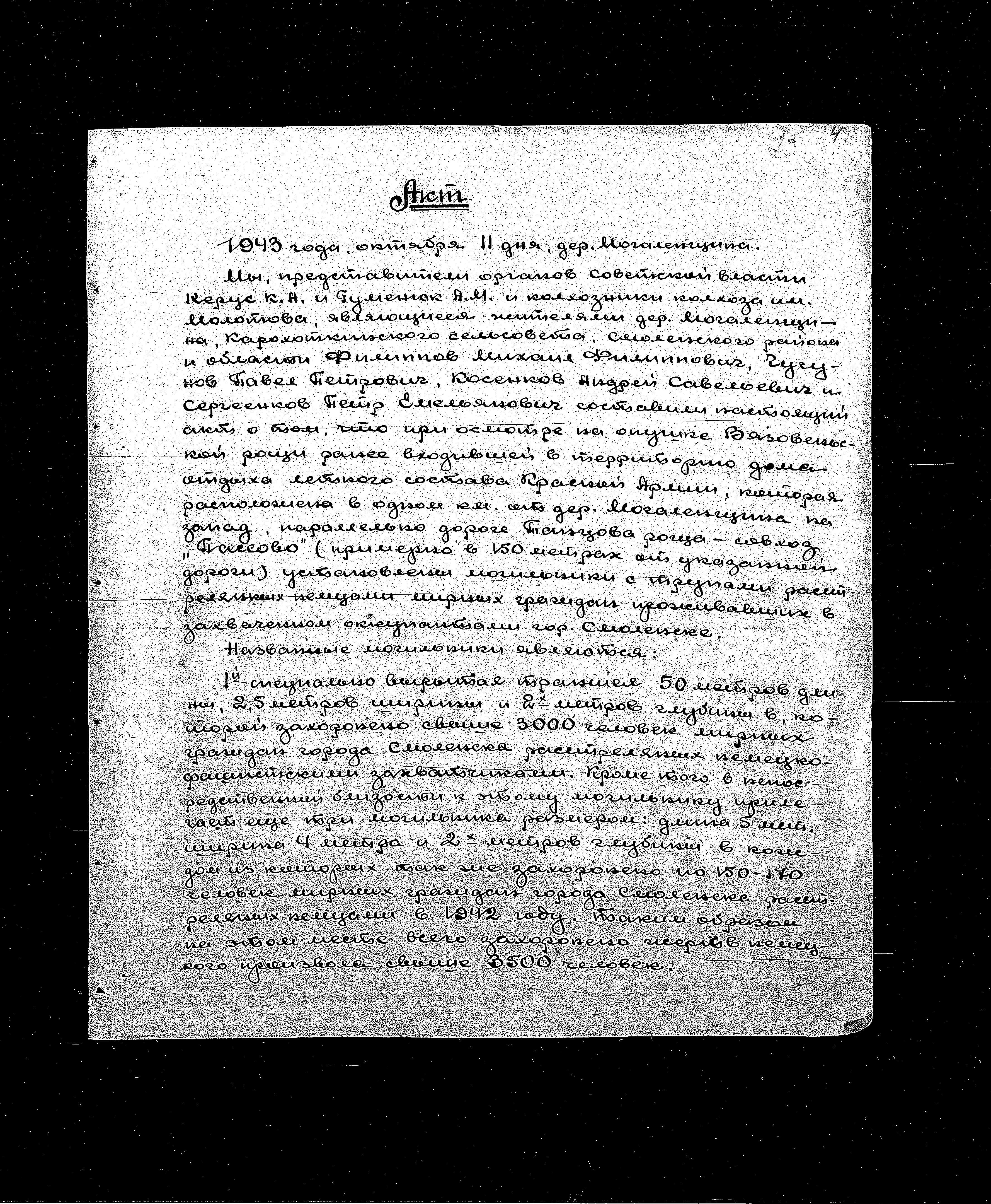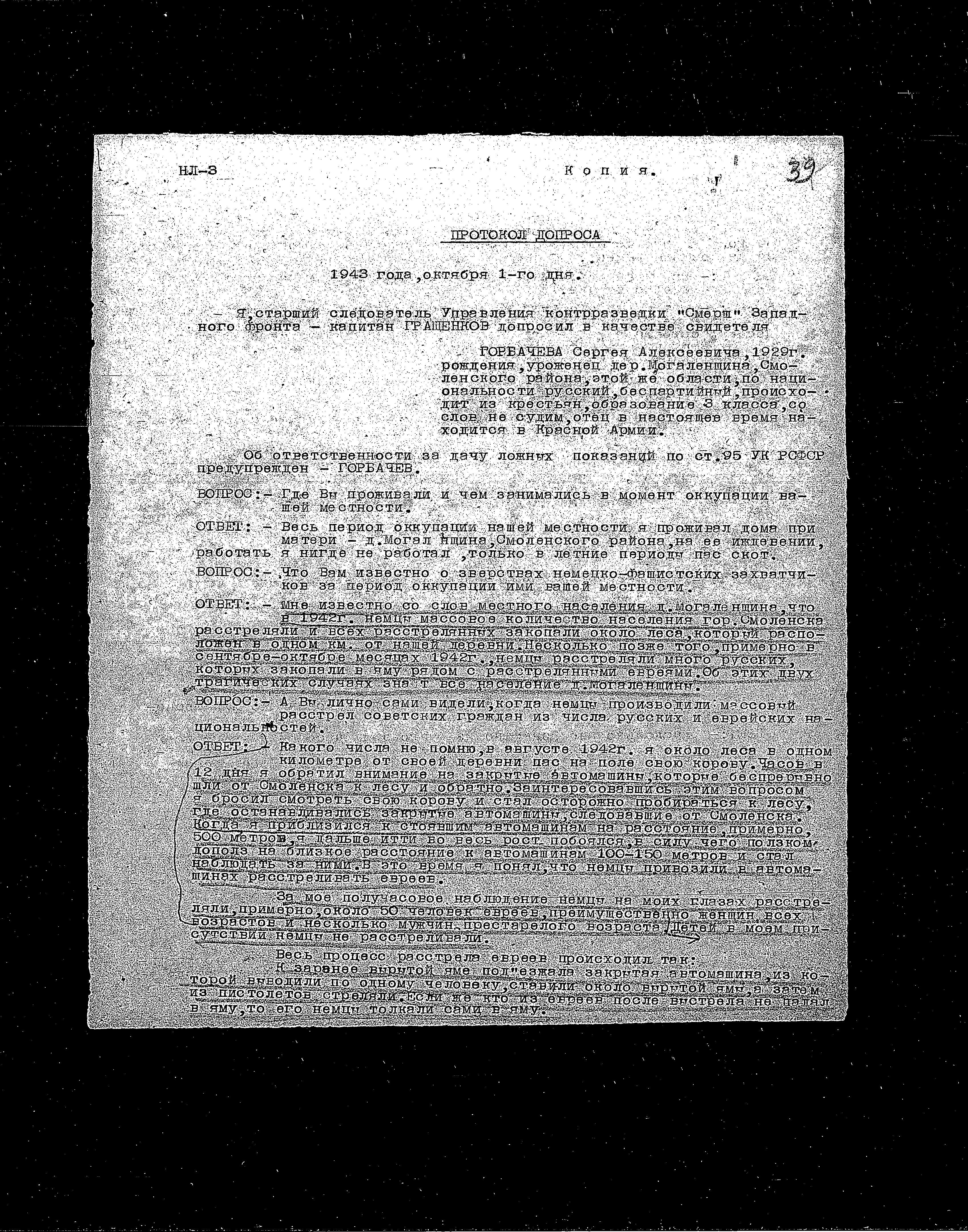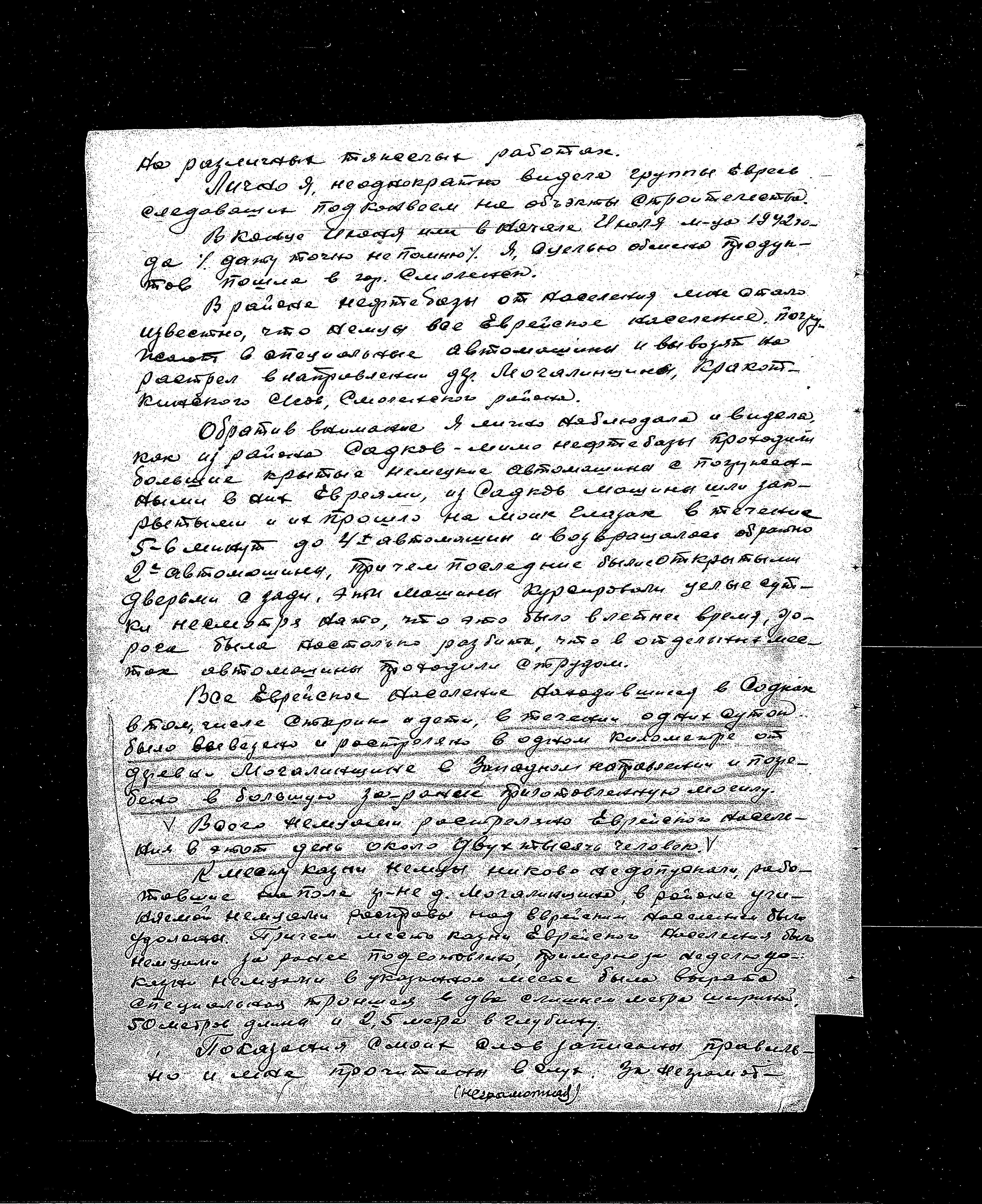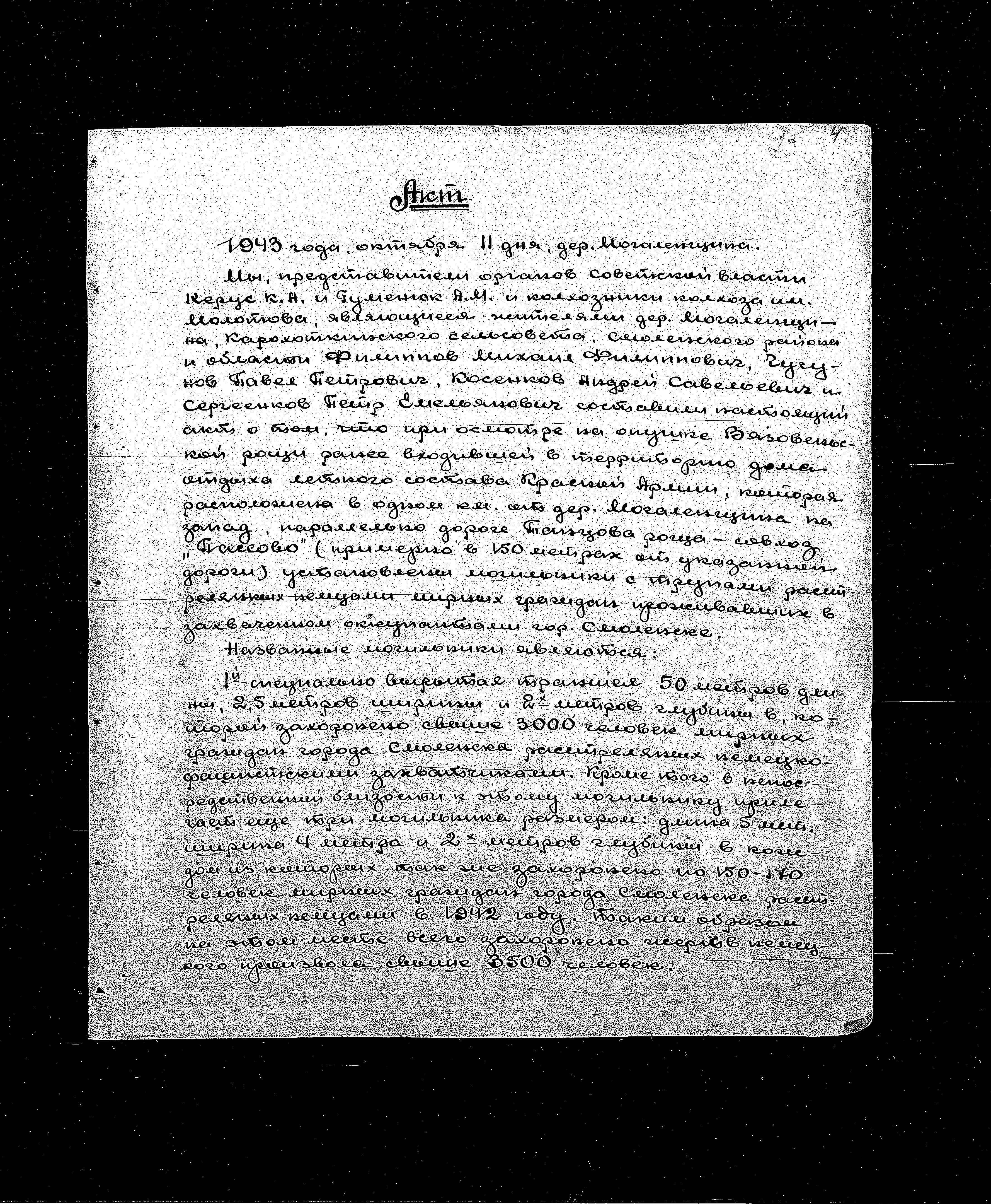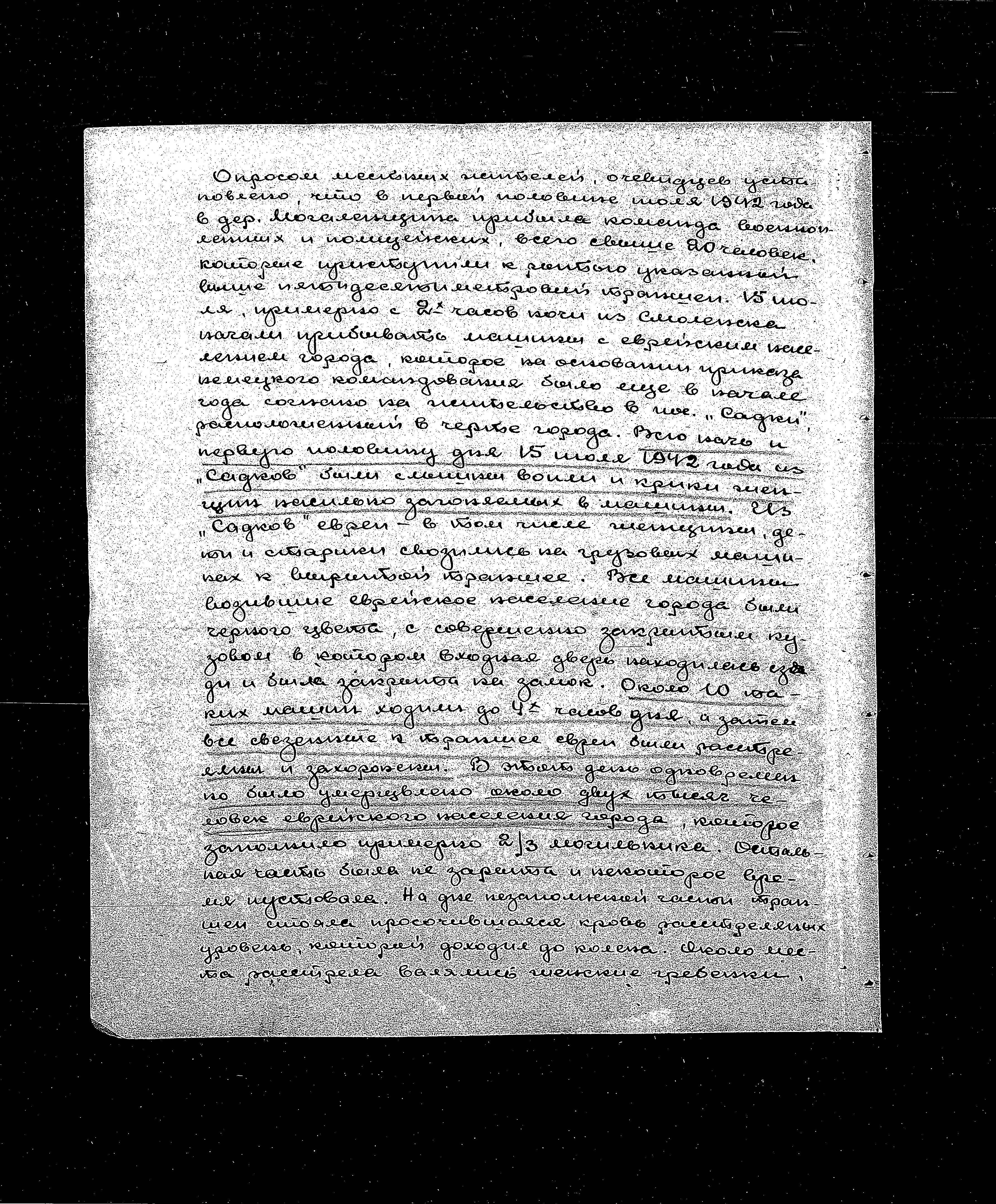Vyazovenskaya Grove Related Communities
# Follow us
Languages
English
עברית
Русский
español
Deutsch
Français
ABOUT THE HOLOCAUST
RESEARCH & COLLECTIONS
COMMEMORATION
EDUCATION & E-LEARNING
MUSEUMS & EXHIBITIONS
RIGHTEOUS

Murder story of Smolensk Jews in the Vyazovenskaya Grove
Murder Site
Vyazovenskaya Grove
Russia (USSR)
On July 15 (according to other sources, July 16), 1942, around 2 a.m., the Germans began to take Jews from the ghetto by truck to the Vyazovenskaya grove, one kilometer west of Mogalenshchina village, about 150 meters from the road from the Tantsova grove to the Passovo state farm (sovkhoz). (Some sources identify the murder site as having been in the vicinity of Gedeonovka village.) The trucks brought the Jewish victims to the murder site and returned to the ghetto for the next group. The Jews were taken to a large trench that had been prepared in advance by a group of prisoners of war. The undressed victims got out of the trucks one after the other. They were forced into the trench and then shot. Those who somehow were neither shot nor fell into the trench were pushed into the trench by the Germans. According to some sources the children younger than 8 were not shot but thrown into the trench alive.
Most sources stress that Jews were taken by black trucks that were completely covered and had their back doors locked. These may have been the gas vans where some of Smolensk Jewish victims were gassed on the way to the murder site.
Related Resources
ChGK Soviet Reports
Representatives of the local authorities and the local residents stated:
... Examination of the edge of the Vyazovskaya grove … that is located one kilometer west of Mogalenshchina village, about 150 meters from the road from the Tantsova grove to the Passovo sovkhoz discovered burial grounds with bodies of innocent Smolensk civilians who had been shot by the Germans during the occupation. Questioning of local residents and witnesses revealed that in the first half of July 1942 a group of prisoners of war and policemen, totaling over 20 people, arrived at the village of Mogalenshchina. They began digging the 50-meter long trench mentioned above. On July 15, 1942, approximately at 2 a.m., trucks bringing Jews from the city began to arrive from Smolensk. There, at the beginning of the year, they had been forced into a ghetto in the Sadki neighborhood within the city limits. During the night and the following morning the cries of women forced to get into the trucks were heard from Sadki. From Sadki the Jews – consisting of women, children, and old people - were taken to the trench that had been dug. All the trucks that took the city's Jewish population away were black in color, with completely covered bodies, each of which had an entry door at the back that was locked. About ten such trucks made round trips until 4 p.m. By then all the Jews had been taken to the trench and buried. On that day about 2,000 of the city's Jews were murdered at that time. That filled 2/3 of the grave.… The rest of the grave was not covered and remained empty. On the bottom of the empty part of the trench the blood of the victims was knee high and soaked [the earth]. At the murder site there were women's combs and hairpins, torn men's and women's clothing, children's shoes, and other items that had belonged to the Jews of Smolensk city who had been shot to death....
GARF, MOSCOW R-7021-44-1092 copy YVA M.33 / JM/21183
Residents of Pervokrasinskaya Street in Smolensk testified:
... All the Jewish population was annihilated with exceptional brutality. All the Jews were relocated to the Sadki neighborhood, where a ghetto had been established. On July 16, 1942 the Germans took the Jews from the ghetto in special gas vans beyond Gedeonovka. Poison gas was introduced into the van during the ride. The brutally murdered [people] were thrown into a ditch beyond Gedeonovka. A total of about 1,500 Jews - men, women, old people, and children - were murdered. Among the murder victims were residents of our street – [members of] the Romanov family, the mother Sarah Zalmanovna, age 64, a housewife; her daughter Elena Moiseevna, age 22, a […] factory worker; Roza Moiseevna, age 30, a restaurant worker; Tatyana Moiseevna, age 27, a local council member; Sofya Moiseevna, age 25, a doctor, and her daughter Ludmila, aged 2.5 years; and [members of] the Volf family – Roza Moiseevna, age 60, the mother, and Lev Moiseevich, age 70, the father....
GARF, MOSCOW R-7021-44-15 copy YVA M.33 / JM/21181
Sergey Gorbachev, who was born in 1929 in Mogalenshchina village and lived there during the war years, testified:
... In 1942, I do not remember the [exact] date, I let my cow graze near the forest one kilometer from my village. Around midday my attention was drawn to some covered trucks that continued to arrive from Smolensk at the forest and return. I became interested in this matter and left my cow so that I could cautiously approach the forest where the covered trucks from Smolensk stopped. When I came nearer, 500 meters from the trucks - I was afraid to walk further so I proceeded by crawling closer, 100-150 meters from the trucks, and began to observe them. At that moment I understood that the Germans were bringing the Jews by truck to the shooting site. During the half an hour of my observation the Germans shot approximately 50 Jews right in front of my eyes. Most of the Jews were women of all ages and several old men. The Germans did not shoot any children when I was there. The whole process was organized in the following way: a covered truck approached the pit that had been prepared in advance. One after another, the people were taken out of the truck and placed next to the pit that had been dug and then they were shot from pistols. If one of the Jews did not fall into the pit, the Germans pushed him into the pit…. At the shooting site I saw about fifteen people dressed in German uniforms but I did not know who they were - Germans or [local] policemen. Around the shooting site there were guards armed with submachine-guns also wearing the uniforms of German soldiers. While I was lying in the grass watching the Jews being shot I heard German being spoken, but not Russian…. Rumors that circulated in the village said that more than 2,000 Jews were shot on that day....
GARF, MOSCOW R-7021-44-1092 copy YVA M.33 / JM/21183
Varvara Mesyukova, who was born in 1894 in Mogalenshchina village and lived there during the war years, testified:
At the end or at the beginning of July, 1942, I do not remember the exact date, I went to Smolensk… in the vicinity of the oil depot I learned from the local population that the Germans had loaded all the Jewish population onto special trucks and taken them to be shot in the direction of Mogalenshchina village, Krakotkinsky County, Smolensk District.
I paid attention [to that] and I personally watched and saw large covered German trucks loaded with Jews drive from the Sadki neighborhood past the oil depot. Up to 4 trucks passed me within 5 or 6 minutes and then two trucks returned and I noticed that their back doors were open….
All the Jews who had been in Sadki, including old people and children, were taken within 24 hours and shot one kilometer west of Magalenshchina village. They were buried in a previously prepared grave. Altogether the Germans shot about 2,000 people that day. The Germans did not allow anyone to come close to the execution site.… The site of the Jews' execution had been prepared by the Germans in advance. Around a week before a special trench more than 2 meters wide, 50 meters long, and 2.5 meters deep had been dug....
GARF, MOSCOW R-7021-44-1092 copy YVA M.33 / JM/21183
Vyazovenskaya Grove
grove
Murder Site
Russia (USSR)
54.783;32.05
Photos
Vyazovenskaya grove murder site
GARF, MOSCOW R-7021-44-1092 copy YVA M.33 / JM/21183
Vyazovenskaya grove murder site
GARF, MOSCOW R-7021-44-1092 copy YVA M.33 / JM/21183

